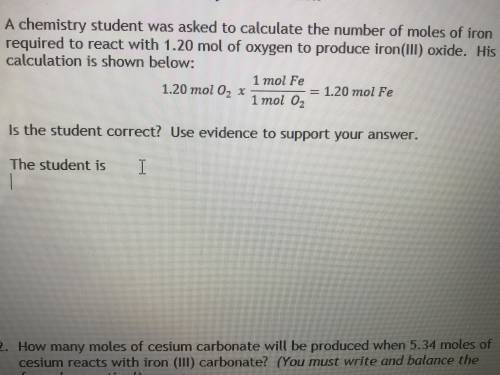
Chemistry, 23.04.2020 21:31 janighad01
A chemistry student was asked to calculate the number of moles of iron required to react with 1.20 mol of oxygen to produce iron (iii) oxide. his calculation is shown below :
1.20 mol O2 x 1 mol fe / 1 mol O2 = 1.20 mol Fe
Is the student correct? Use evidence to support your answer.


Answers: 3


Other questions on the subject: Chemistry


Chemistry, 22.06.2019 17:40, zayo8468
Experiment: effect of solution concentration on reaction rate you have learned that as the concentration of reactants increases, there will most likely be a greater number of collisions, and hence increase the rate of a reaction. in this experiment, you will see a demonstration of this, with a twist. there will be three reactions going on in this experiment. objectives determine how solution concentration can affect the rate of a reaction. the first reaction will be a reaction of the iodide ion (i-1) with hydrogen peroxide (h2o2) in an acidic solution. this reaction produces a slightly orange solution. in our experiment, we will add some orange food coloring to make this solution more orange. 2 h+ (aq) + 2 i- (aq) + h2o2 (aq) ⟶ i2 (aq) + 2 h2o (l) the next reaction will be between the iodine and starch i2 + starch ⟶ i2-starch complex (blue-black) so, when starch is added to the iodine solution made from the first reaction, the solution will turn black immediately, so it is difficult to find the rate of reaction. in order to be able to time this reaction, you will slow it down with another reaction. adding ascorbic acid will react with the iodine, reducing the concentration of the iodine available to react with the starch. c6h8o6 (aq) + i2 (aq) ⟶ 2i- (aq) + c6h6o6 (aq) + 2 h+ (aq) when the ascorbic acid is used up, the remaining iodine molecules can react with the starch and form the black color. the more ascorbic acid you add, the slower the reaction to form the iodine-starch complex will be. use your data and observations to complete the assignment. analysis and conclusions submit your data and the answers to these questions in the essay box below. what was your hypothesis? plot your data as drops of ascorbic acid vs. time. as the concentration of ascorbic acid was increased, did the rate of the formation of the iodine-starch complex increase or decrease? explain your answer in terms of the chemical reactions involved. was your hypothesis correct? make a general rule about the effects of concentration of reactants on reaction rates. for practice, the molecular formula for ascorbic acid is c6h8o6, and you used 6 g in this experiment, calculate the molarity of the ascorbic acid. now calculate the concentration in moles per drop (assume 1 ml = 20 drops).
Answers: 3

Chemistry, 22.06.2019 19:20, johnkings140
For a research project, a student decided to test the effect of the lead(ii) ion (pb2+) on the ability of salmon eggs to hatch. this ion was obtainable from the water‐soluble salt, lead(ii) nitrate, which the student decided to make by the following reaction. pbo(s) + 2 hno3(aq) → pb(no3)2(aq) + h2o losses of product for various reasons were expected, and a yield of 86.0% was expected. in order to have 5.00 g of product at this yield, how many grams of pbo should be reacted? (assume that sufficient nitric acid, hno3, would be used.)
Answers: 1

Chemistry, 23.06.2019 01:00, aliviadushane
If a straight-chain hydrocarbon is a gas at room temperature, how many carbon atoms will it have? a. 6 carbon atoms b. 12 carbon atoms c. 24 carbon atoms d. 3 carbon atoms
Answers: 1
You know the right answer?
A chemistry student was asked to calculate the number of moles of iron required to react with 1.20 m...
Questions in other subjects:

Mathematics, 01.09.2021 01:50


History, 01.09.2021 01:50

Mathematics, 01.09.2021 01:50

Mathematics, 01.09.2021 01:50


History, 01.09.2021 01:50


Mathematics, 01.09.2021 01:50

History, 01.09.2021 01:50



